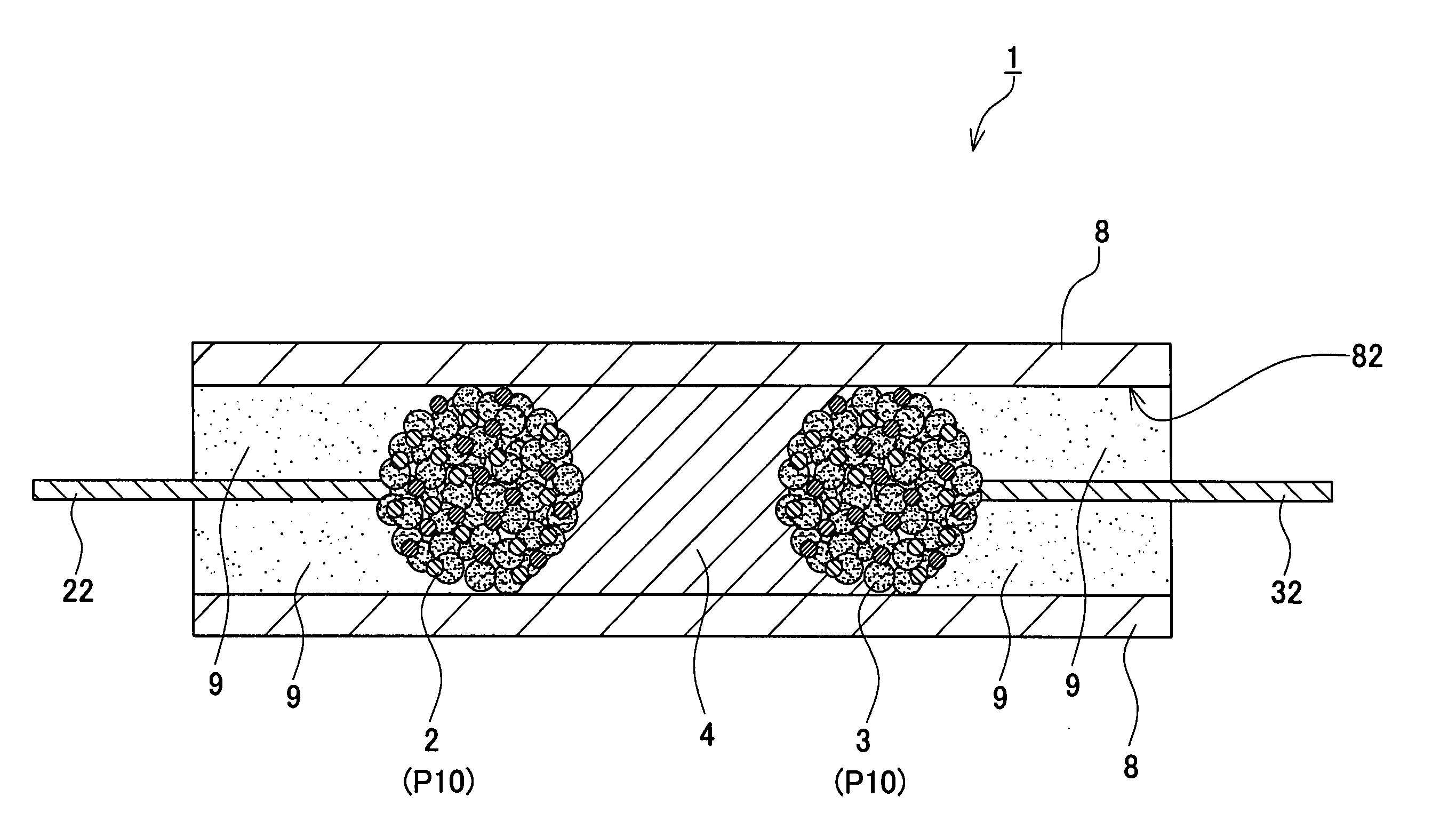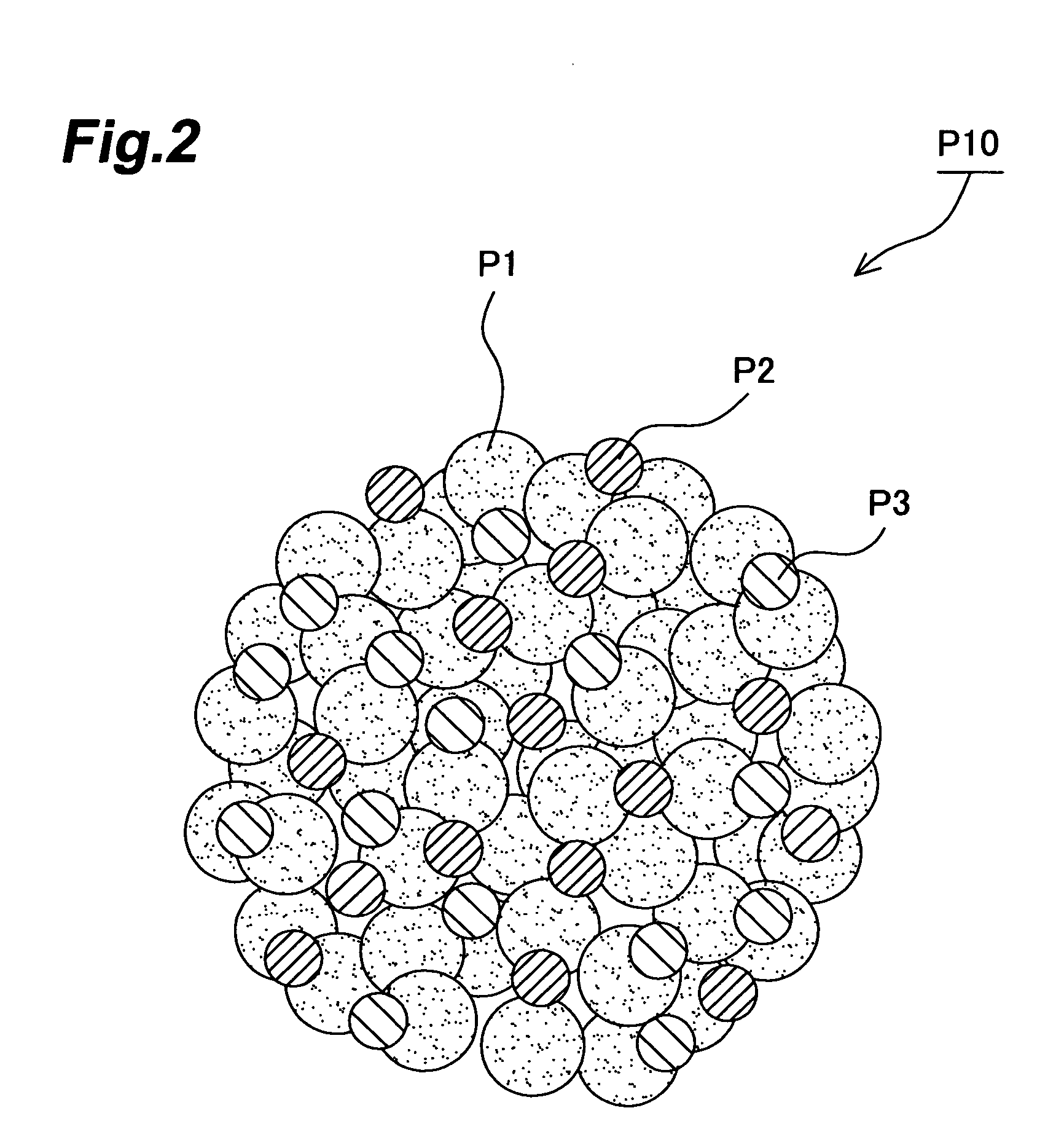Electrochemical device
a technology of electrochemical devices and electrodes, which is applied in the direction of non-aqueous electrolyte cells, cell components, sustainable manufacturing/processing, etc., can solve the problems of difficult to place in a minute space, fail to efficiently utilize space, and yield dead space, etc., to achieve convenient and convenient placement, and easy to be accommodated
- Summary
- Abstract
- Description
- Claims
- Application Information
AI Technical Summary
Benefits of technology
Problems solved by technology
Method used
Image
Examples
example 1
[0138] (1) Making of Composite Particle
[0139] In the following procedure, a composite particle to become a cathode of a lithium ion secondary battery was made by a method including the above-mentioned granulating step. Here, the composite particle P10 was constituted by a cathode electrode active material (90 mass %), a conductive auxiliary agent (6 mass %), and a binder (4 mass %).
[0140] As the cathode electrode active material, particles (each having a BET specific surface area of 0.55 m2 / g and an average particle size of 12 μm) of a mixed metal oxide satisfying a condition in which x=1, y=0.33, z=0.33, and w=2 in mixed metal oxides represented by the general formula of LixMnyNizCo1-x-yOw was used. As the conductive auxiliary agent, acetylene black was used. As the binder, polyvinylidene fluoride was used.
[0141] First, in the material liquid preparing step, acetylene black was dispersed into a solution in which polyvinylidene fluoride was dissolved in N,N-dimethylformamide [(DM...
example 2
[0162] (1) Making of Composite Particle
[0163] In the following procedure, composite particles to become an anode (first electrode) and a cathode (second electrode) of an electric double layer capacitor were made by a method including the above-mentioned granulating step. Here, the composite particle P10 was constituted by an electrode active material (88 mass %), a conductive auxiliary agent (4 mass %), and a binder (8 mass %).
[0164] As the electrode active material, short fibrous steam-activated carbon (having a BET specific surface area of 2000 m2 / g and an average particle size of 17 μm) was used. As the conductive auxiliary agent, acetylene black was used. As the binder, polyvinylidene fluoride was used.
[0165] First, in the material liquid preparing step, acetylene black was dispersed into a solution in which polyvinylidene fluoride was dissolved in N,N-dimethylformamide [(DMF), i.e., solvent], so as to yield a “material liquid” (containing 1.5 mass % of acetylene black and 3 ...
example 3
[0180] (1) Making of Electrode
[0181] In the following procedure, the electrode for the electric double layer capacitor was made. First, a method of forming an anode will be explained. As the electrode active material, short fibrous steam-activated carbon (having a BET specific surface area of 2000 m2 / g and an average particle size of 17 μm) was used. As the conductive auxiliary agent, acetylene black was used. As the binder, polyvinylidene fluoride was used. In the above-mentioned granulating step, a composite particle was made such that the mass ratio of electrode active material / conductive auxiliary agent / binder=88:4:8. Using this composite particle alone, an electric double layer capacitor electrode including an active material containing layer having a thickness of 100 μm was obtained by a hot roll press.
PUM
| Property | Measurement | Unit |
|---|---|---|
| Volume | aaaaa | aaaaa |
| Particle size | aaaaa | aaaaa |
| Melting point | aaaaa | aaaaa |
Abstract
Description
Claims
Application Information
 Login to View More
Login to View More - R&D
- Intellectual Property
- Life Sciences
- Materials
- Tech Scout
- Unparalleled Data Quality
- Higher Quality Content
- 60% Fewer Hallucinations
Browse by: Latest US Patents, China's latest patents, Technical Efficacy Thesaurus, Application Domain, Technology Topic, Popular Technical Reports.
© 2025 PatSnap. All rights reserved.Legal|Privacy policy|Modern Slavery Act Transparency Statement|Sitemap|About US| Contact US: help@patsnap.com



